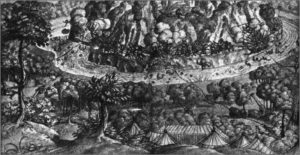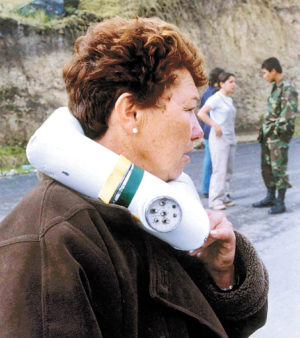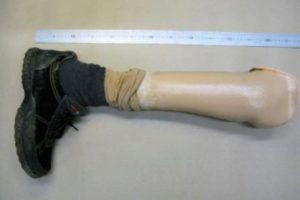Readers of the blog will know I’m researching 16th century IEDs. This one is worth a blog.
The development of explosive devices required a number of technological developments. In the 14th and 15th century the manufacture of saltpeter (Potassium nitrate) became industrialized allowing the production of volumes of blackpowder. (I’m simplifying things here for the short space appropriate in a blog). Then with the invention of the Wheelock for firearms in the early part of the 16th century, this allowed for command initiation, by pull by using the initiation system for a gun in an explosive charge. There are a few red herrings around with regard to the use of Iron Pyrites and flint, which in a flintlock in the early 1600s became the favored option once stronger steel was made that wouldn’t be eroded by the flint – pyrites being the spark provider when earlier, softer steel was used in firearms. But of course in an explosive device the “lock” is only going to be used once, so I suspect flint initiation in a Wheelock mechanism, was the first use in IEDs in the 1500s.
The other engineering development in the 16th century that is pertinent is the clock. Clocks became more widespread, as a cultural phenomenon and as technology permitted smaller clocks (I’m simplifying a chapter of my book here, into two sentences). The first clock-initiated IEDs occurred in the 16th century. I can’t tell you exactly when the first one was, but I provide below the details of the incident that is the earliest incident where I can find details of such a device. It is significant too, because I think it may be the IED that caused the greatest number of fatalities, ever, with possibly as many as 1000 killed. Possibly, too, the biggest ever IED. Possibly, too, the first ever WMD. It also has a significant impact on a whole war in terms of the terror it gave, I believe too on the eventual defeat of The Spanish Armada, some years later, when they scattered before the British fleet, at least partly in fear of a similar device.
In 1584 the city of Antwerp was under siege and blockaded by the Spanish Army following a rebellion. An Italian Engineer, in the secret pay of the English, was supporting the Dutch rebels. In order to destroy a huge pontoon bridge the Spanish had constructed, he was given two Seventy ton ships, the Fortuyn and the Hoop. (“Fortune” and Hope”).
The concept of fire ships was already known and had been used already by the Dutch. But Giambelli, the Italian had bigger ideas. He constructed two massive IEDs, one in each ship. And when I say massive, I mean massive. He was helped by two key individuals, Bory, a clock maker from Antwerp and Timmerman, a “mechanic”. Here’s a description of how each was made from a source document I found recently:
In the hold of each vessel, along the whole length, was laid down a solid flooring of brick and mortar, one foot thick and five feet wide. Upon this was built a chamber of marble mason-work, forty feet long, three and a half feet broad, as many high, and with side-walks five feet in thickness. This was the crater. It was filled with seven thousand pounds of gunpowder, of a kind superior to anything known, and prepared by Giambelli himself. It was covered with a roof, six feet in thickness, formed of blue tombstones, placed edgewise. (Note: some sources say also this was sealed with lead) Over this crater, rose a hollow cone, or pyramid, made of heavy marble slabs, and filled with mill-stones, cannon balls, blocks of marble, chain-shot, iron hooks, plough-coulters, and every dangerous missile that could be imagined. The spaces between the mine and the sides of each ship were likewise filled with paving stones, iron-bound stakes, harpoons, and other projectiles. The whole fabric was then covered by a smooth light flooring of planks and brick-work, upon which was a pile of wood: This was to be lighted at the proper time, in order that the two vessels might present the appearance of simple fire-ships, intended only to excite a conflagration of the bridge.
The initiation system for the Fortuyn was a slow burning fuse, while the Hoop, courtesy of Mr Bory the clockmaker, was initiated with an adapted clock. I’m guessing the striker of the clock was a modification of a firearm lock, wheel-lock or flintlock. One source suggests that the time delay was one hour. These ships were sent down the waterway with skeleton crews, along with 32 “normal” fireships, with the crews as usual setting them alight before getting away in small boats, allowing the currents, tides and winds to carry them towards the pontoon bridge.
The Fortuyn failed to be carried towards the best target and then when the charge exploded, it only partially functioned, causing no damage and no injuries. The entire Spanish Army, called to the alert on the approach of the fire ships, to fend them off and extinguish the fires, was heard jeering. But the Hoop bore down on its target and became entangled with Spanish ships and the bridge itself. As soldiers boarded her to extinguish the fire on her deck, the clock ticked, … then struck. 7,000 pounds of blackpowder, reputedly the best Antwerp possessed, exploded and the pontoon bridge, many ships and hundreds of soldiers disappeared. Some sources say 800 Spanish soldiers were killed at that instant, others put the figure at 1000. Many remarkable tales exist about oddities of the explosive effect. (Detail will follow in the book!) Two of the Spanish generals bodies were found some time later, their bodies thrown considerable distances.
Although the Antwerp rebels were unable to exploit the effect of the explosion, probably because they too were simply shocked by its effect, the incident achieved immediate notoriety across Europe and great interest from military experts who recognized this as a new type of warfare.
Three years later when the Spanish Armada came to invade England, the use of fireships caused panic among the Spanish fleet, because of concerns that they could be loaded with explosives.. and by then they knew that Giambelli was overtly in England, working for the Queen. The Spanish Fleet was seriously disrupted and control of it was never regained by its admirals. And as a result, my Spanish language skills are limited today to ordering “Dos cervezas, por favor” I have grossly simplified a complex action here, but hopefully blog readers will appreciate the unusual construct of the IED on the Fortuyn and the Hoop, and see the significance of the initiation mechanism. In another aside and related to the last post about the assassination of generals….When the Prince of Parma, the Spanish General did ride into Antwerp, some months later, a conqueror, there had been a plot to kill him and everybody near him by blowing up a street over which it was calculated he would be sure to pass. Nothing came of this, because the plot was revealed before the procession occurred.
One final thought…. The Hoop attack concept was used again… in 1809 when British Admiral Cochrane attacked the French in the Basque Roads attack, and again in 1942, when the bomb ship HMS Campbelltown rammed the gates of the drydock in the St Nazaire raid as part of “Operation Chariot”.






